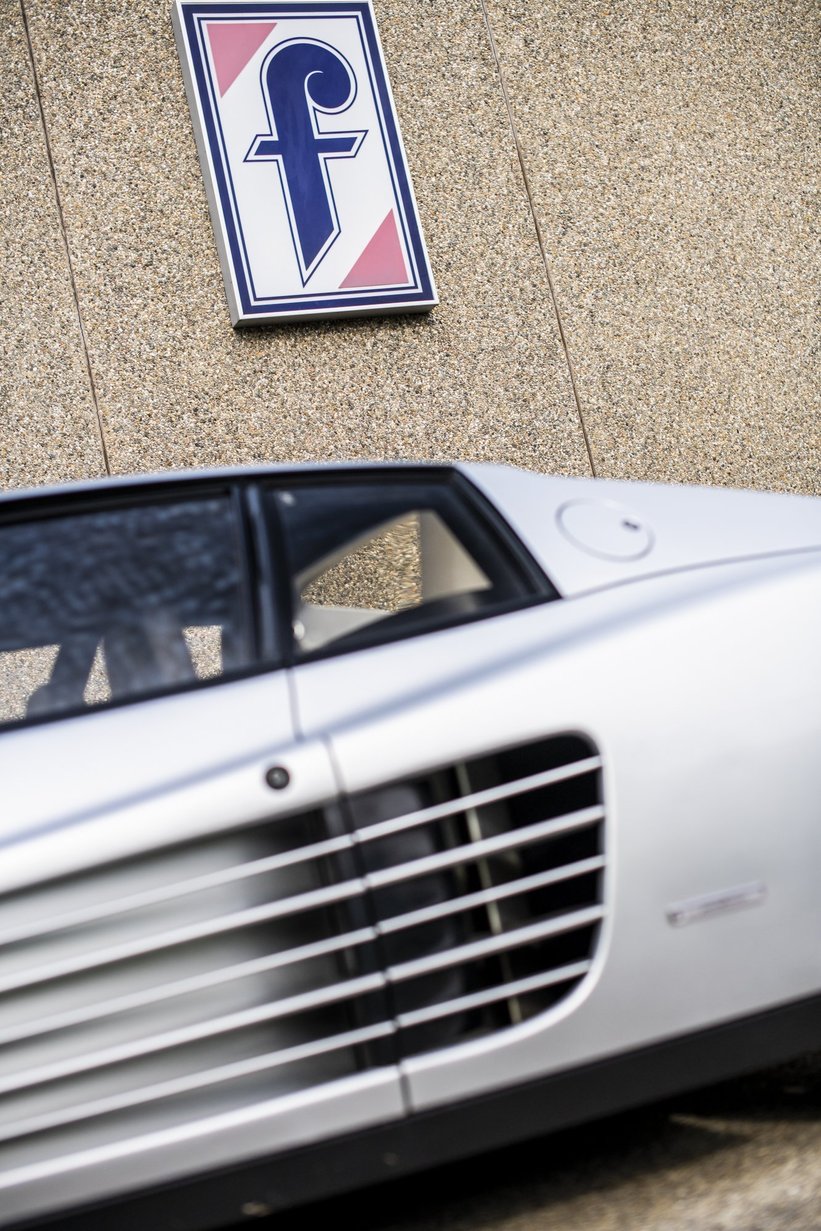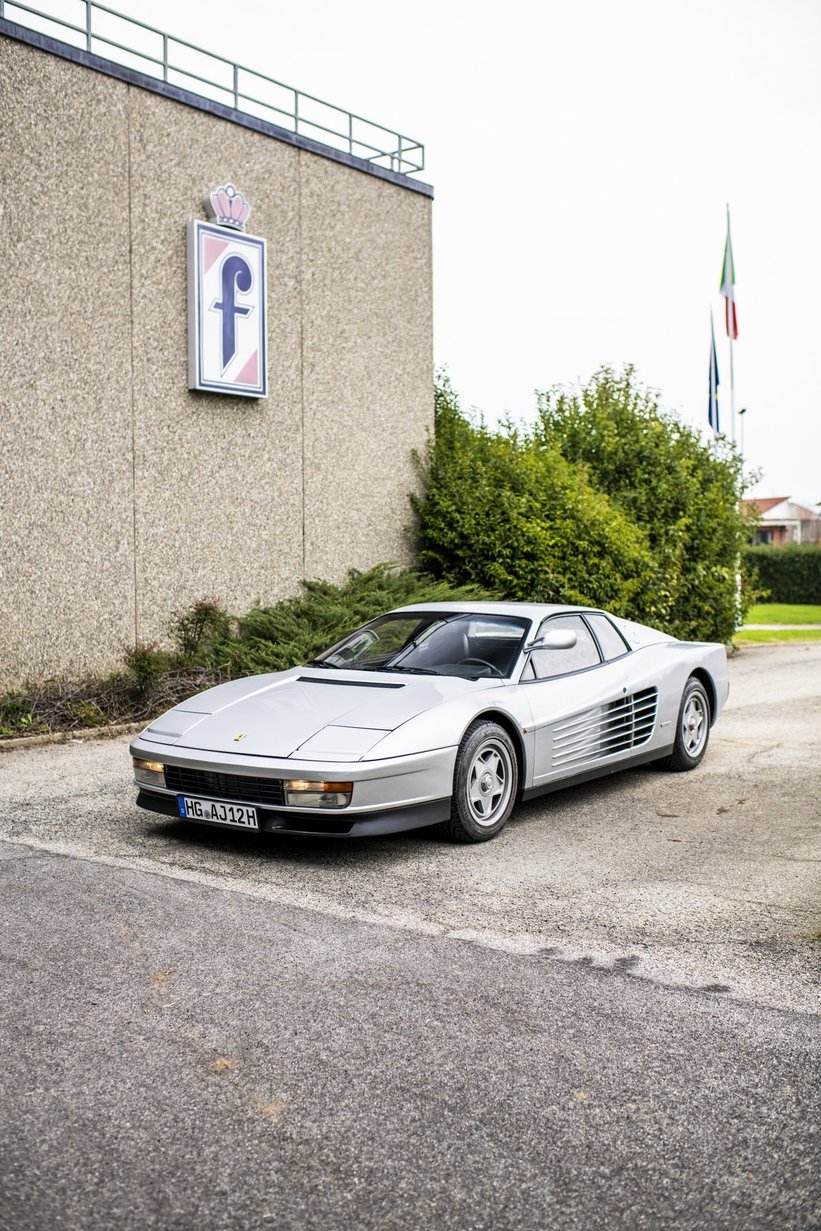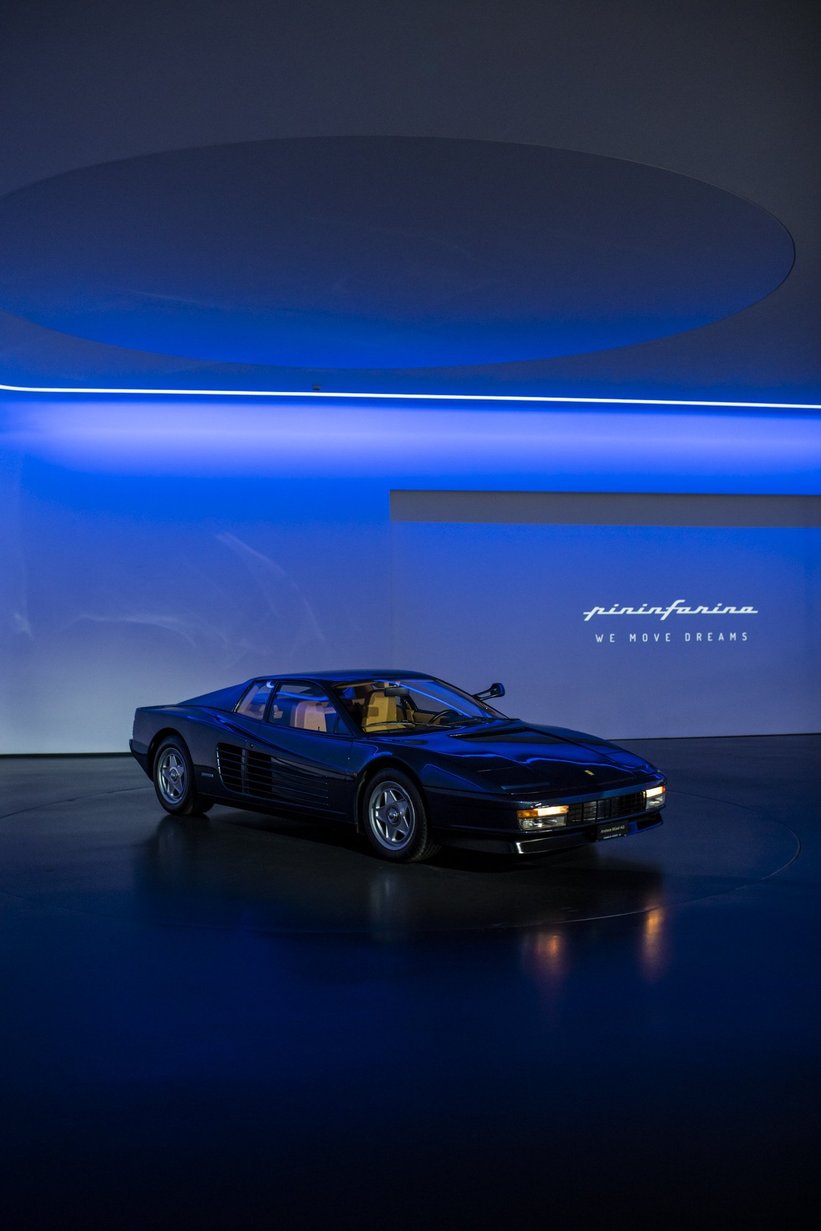
Of all the Ferraris built in the last 50 years, the Testarossa is probably the most iconic. Revealed in 1984 during a kinky revue at “Le Lido” in Paris, the wedge-shaped wonder took the world by storm, becoming the ultimate poster car of the 1980s. Starring in TV shows like Miami Vice and the first video games of the era, the mid-engined flat-12 sportscar became an icon of pop culture and a symbol for the era’s excess and flamboyance. Its distinct avant-garde shape and signature air vents influenced car designers for decades to come, or as one of our readers recently put it on Instagram: “The Testarossa is Ferrari's ferrariest Ferrari yet.”


We at Classic Driver have adored the Ferrari Testarossa since our childhood days. But for the car’s 40thanniversary, we wanted to fade out all the fame and glory to focus on the car’s prelude – the story of how the Testarossa was created. So we shared our idea for a trip back in time with our friends at Pininfarina and invited Leonardo Fioravanti – the legendary design master and engineer who oversaw not only the development of the Testarossa, but almost all Ferraris of the 1970s and 1980s as Pininfarina’s head of design. The idea of our capsule event evolved, and soon Leonardo Fioravanti was joint by Diego Ottina, who worked on the Testarossa as an exterior designer, the former Pininfarina CEO Lorenzo Ramaciotti, who oversaw the car’s evolution after 1988, as well as Pininfarina’s current Chief Creative Office, Felix Kilbertus. Only Ian Cameron – the Testarossa’s interior designer – was dearly missed after his tragic passing earlier this year.

It was a meeting of design masters. However, proper birthday parties need guests, so we invited a small group of design enthusiasts and owners who joined in our celebrations on this special day. In contrast to the rather impractical Ferrari Berlinetta Boxer of the 1970s, the Ferrari Testarossa was designed to be a grand tourer – and it was a pleasure to see it driven just like it was intended. While some guests drove their cars on long-distance trips from Monaco and Berlin, one courageous owner from Frankfurt steered his silver ‘Monospecchio’ during a daring night drive across the snow-covered San Bernardino pass just to make it in time for the event. That’s the spirit!


Meanwhile, Pininfarina’s design team had been digging in the archives searching for original drawings, sketches and blueprints to illustrate the Testarossa’s design development. Based on these fascinating artefacts we were able to recreate a period-correct design review in one of Pininfarina’s presentation rooms in Cambiano. Many of the fascinating sketches date back to 1978, when Ferrari first commissioned Pininfarina to come up with a successor for the 512 BB. Designed by Leonardo Fioravanti, the brand’s first mid-engined 12 cylinder road car had been hailed for its elegance and performance – but it never met the strict US legislations and therefore failed to sell abroad. The next 12-cylinder flagship was supposed to take back this important market for Ferrari. And Pininfarina had to find a solution.

In order to hear the story of the Ferrari Testarossa’s origin from its maker, we moved on to the next room for a panel talk featuring Leonardo Fioravanti, Felix Kilbertus and Classic Driver’s CEO, J.P. Rathgen. But before the start of the discussion, guests had the opportunity to explore the two hero cars of our “Blueprint” event – a beautiful blue-over-tan Monospecchio from the stables of our Swiss friend Andy Wüest and a black-over-red one-off Spider custom-built in the early 1990s for the legendary racing driver and four-time Le Mans winner Olivier Gendebien. We will tell you the incredible story of this unicorn car in the future. After a round of admiration for these two very different automobiles, the guests and a group of young designers from the Pininfarina studios took their seats, eager for the start of the discussion (which we present you here in shortened and edited form):


Mr. Fioravanti, apologies for addressing you in English today, not in Italian. But we have a translator who will assist us.
I do speak English. But we are at Pininfarina. We talk about a Ferrari. I am Fioravanti. So it’s a question of philosophy that I speak in Italian today.



Of course. Going back to the late 1970s, what was the initial problem of the Ferrari BB that you were asked to solve?
The main shortcoming of the Berlinetta Boxer was that it had a big water radiator in the front. It needed a lot of space, so the luggage compartment was very small. Also, the hot water from the mid-engine was led to the radiators through pipes in the cabin, so the cockpit was always hot. I wanted to find a solution to this and decided to remove the front water radiator. I left the air conditioning radiator and moved the ducts to the sides of the car, just behind the driver, much closer to the engine.

Did Ferrari like this idea?
To me, this solution offered a number of advantages. So it was decided to submit it to Il Commendatore, Enzo Ferrari. However, the Ferrari engineers were against it. They wanted to use the BB chassis for the new car and therefore keep the position of the ducts. With my solution this wasn’t possible, so we went to Maranello to propose our ideas, while the engineers presented theirs.


So how did you manage to convince Enzo Ferrari?
I knew him very well so I could read his face. And the commendatore looked a bit thoughtful. He was still thinking about it. I repeated my proposal in much simpler terms. And then I had an idea. I said, you know, Commendatore, the side radiators are exactly the ones that you are using in Formula 1. And that was the magic word which opened all doors.

What happened after you received green light from Maranello? How did the Testarossa get its shape?
The aerodynamics and the structural work which was implied by this new design was massive compared to the restyling of an existing car. From an aesthetic point of view, the big air intake of the previous Ferraris disappeared, replaced by a thin air intake which was only for the radiator of the air conditioning. So we created a completely new front. Then we had to find the perfect position for the air ducts on the side. We spent many hours in the wind tunnel to study how to make the air enter laterally into the radiator. So in the end the air intakes were established in the door and also the section directly behind it.


These big side air intakes became a key design element of the Ferrari Testarossa. But why did you decide to add horizontal fins to it?
Well there was a strange regulation in Germany at the time that was meant to prevent the head of a child from entering such an opening during an accident. Ferrari exported many cars to Germany, so we needed to take it seriously – and installed the fins. But they also had an aerodynamic advantage, as they made the lateral flow less wavy to avoid turbulences in the air circulation. We also added two vertical fins that carried the lateral air into the radiators.

Another distinct design feature of the Testarossa is the rear. In the design review we saw that some initial sketches envisioned a bonnet covered in glass.
That was dismissed because the engine developed a lot of heat. In order to optimize the air circulation. We opened the side fins behind the cockpit at the top so that hot air could get out, while wings in the terminal part of the bonnet allowed cold air to enter. For the rear lights, I felt it was time to replace them with something more mysterious. So we replaced the famous four round lights with a new unit and hid it behind a grid. So if the car was driving in front of you and stopped, the brake lights would come up as a surprise.


So how did you manage to turn all these ideas into such a perfect shape?
Well, with all these mechanical solutions, it was still necessary to stylistically design the bodywork. And Diego Ottina – who is with us here today – created the final design. There were a lot of restrictions, but he managed to interpret all these aerodynamic and functional solutions and create the shape we see here today. He worked at it masterfully and did a daunting job. This is really his masterpiece. And so did Ian Cameron with the interior.



The early Ferrari Testarossa models can be identified by the high-position single mirrors, the Monospecchio, and the center wheel caps, the Monodado. Why did you chose these designs – and why did they later change?
Legislation at the time demanded full rear visibility in the side-view mirrors. But the car had a very wide, anscending waste line – so we needed to position the rear view mirror higher than usual so the driver would see what happened in the back. Later the laws changed, we added a second mirror and moved them further down again. The center wheel caps were chosen by me because they were lighter. But it made it more complicated to change the wheel, so for the sake of the clients we replaced them with five-screw-wheels.


How did the people at Ferrari react when they saw the final car?
When it was presented, it was a resounding success across the board. I mean, engineers and designers and everybody just loved it. No criticism came. It was just a success. And so the question was: where are we going to actually present it to the public? And Ferrari decided to reveal it at the Paris Motor Show.

But a few chosen people had the pleasure to catch a sneak peek of the Ferrari Testarossa on the night before the show.
Yes. I received an invitation from Ferrari to join them at “Le Lido” in Paris – which was a famous cabaret – together with my wife. So we sat in the front row, the ladies started dancing and bending, very sparcely clad, and I though: what the hell are they doing? Then suddenly the music ended, the dancers left the stage, there was a lot of smoke – and from a hole in the stage the Testarossa emerged. The crowd went wild, everyone started applauding and screaming. It was mind-blowing. I am 87 years now, I have travelled the world. But I have never seen anything like it again.


And the Ferrari Testarossa became a massive success. Including the Ferrari 512 TR and 512 M, almost 10,000 cars were built between 1984 and 1996.
Yes, the Testarossa was a huge success. The sales went very well. Of course, there were many modifications over the years because of new legislative provisions. But it remained unique.

Besides the well-known Testarossa generations, Pininfarina also built some very special custom cars.
Well, the Testarossa had a daughter. Because Gianni Agnelli, who loved both beautiful women and beautiful cars, had seen the Testarossa and he liked it very much. We knew each other, and he told me that he would like to have a version of it with an open roof. But the roof was important for structural reasons, it was balancing the chassis. So we spoke to the engineers at Ferrari and they created more robust and sturdy chassis. I spoke to Mister Agnelli again and told him that we solved the problem with the chassis, but putting a convertible roof would be difficult. And he said, you know, it doesn' t matter – just put some sort of umbrella on it. We painted the car in his family colours, grey with a blue pinstripe.


So tell us, is the Ferrari Testarossa your favourite design?
You know I started driving when I was 12 years old – in the middle of the night, I would take my father' s car and drive through Milan. And ever since, cars have been part of my life. So it would be very, very difficult for me to say, well, which car I love most, which has the best place in my heart. It's like a beautiful woman. You always remember the last.


Thank you very much for sharing this fascinating story with us today. Felix, you are now in charge of the design of Pininfarina. When did you first see the Ferrari Testarossa – and how does inspire your work today?
It is such an iconic car. It is so omnipresent in many ways that I personally don't even remember when I saw it first – probably on the posters that we all had in our bedrooms, or on TV, from Miami Vice. For me, it’s the quintessential Ferrari, the essence of Italian design. If you think of the Ferraris of the 1950s and 1960s, the shapes were quite sensual and quite organic, really coming from a tradition of hand-built cars. The Testarossa, with its flat surfaces and horizontal lines anticipated the digital aesthetics that became distinctive for consumer electronics the 1980s, like Hi-Fi stereo systems that were all about precision and fine detail. So it is really a symbol of this time.



We have spoken with three of the design masters who created the Testarossa today. How has car design changed since then? Could you still say ‘Let’s put the cooling to the side’ and get away with it?
It really depends on the project. We work with very different clients, and some of them give us a lot of space to really explore vehicle architectures and different product typologies. They come to Pininfarina and want us to explore the future of a segment, they ask us how we can reinvent the SUV. But if you attend a motor show today, you see a much stronger unification of architectures. There are certain typologies that have become the standard. And sometimes, as a designer, you find yourself in a role where you have a lot more restrictions, where you certainly cannot turn the batteries by 90 degrees. So these things have changed. And the stories we heard today reflect a very unique moment in time: To go against the expertise of hundreds of engineers at Ferrari and win the argument, that’s a historical situation as well.
Thank you both for sharing so many beautiful memories and thoughts.



Looking back at our capsule event, we would like to thank our friends from Pininfarina as well as all designers and guests for helping us make this dream come true – and throwing the Ferrari Testarossa a birthday party we won’t forget anytime soon.
Photos: Rémi Dargegen for Classic Driver © 2024




























































































